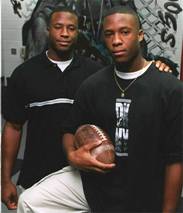BYLINE: By ALAN SCHER ZAGIER, Associated Press Writer
The Associated Press State & Local Wire
June 27, 2007 Wednesday 6:03 PM GMT
SECTION: STATE AND REGIONAL
LENGTH: 775 words
DATELINE: COLUMBIA Mo.
The growing number of exercise-induced deaths among athletes with sickle cell trait can be curtailed with proper treatment and greater awareness among team doctors and athletic trainers, a national medical group said in a report released Wednesday.
 The National Athletic Trainers’ Association report, released at the group’s annual meeting in Anaheim, Calif., only suggests, not recommends, that schools screen players for the inherited blood disorder.
The National Athletic Trainers’ Association report, released at the group’s annual meeting in Anaheim, Calif., only suggests, not recommends, that schools screen players for the inherited blood disorder.
The symptoms of explosive muscle breakdown tied to sickle cell trait are “underrecognized and often misunderstood” by team medical workers who mistake the injury for heat exhaustion, muscle cramps or heart problems, the report found.
“Sickling collapse is a medical emergency,” the report states.
Nine athletes have died under such circumstances in the past seven years, ranging in age from 12 to 19. The NATA study also notes the deaths of 13 college football players at schools that did not test for sickle cell trait or had “a lapse in precautions.”
Three of those deaths occurred over the past three summers. The group includes former Missouri reserve linebacker Aaron O’Neal, who collapsed on the field near the end of a preseason workout in July 2005.
“I have no doubt that I’m very typical of a lot of sports medicine professionals,” said Scott Anderson, head athletic trainer at the University of Oklahoma and a co-chairman of the NATA task force that produced the report.
“There’s knowledge of sickle cell trait, but a great lack of understanding of the associated risks,” he said.
In Missouri, a county medical examiner listed O’Neal’s official cause of death as viral meningitis. That determination was challenged by several people, including outside experts and the chairman of the university’s pathology department.
Individuals with sickle cell trait have one normal gene for hemoglobin, the protein in red blood cells, and one abnormal gene. Unlike normal, rounded red blood cells, the sickle-shaped cells carry less oxygen and can clog blood vessels that flow to the heart and other muscles.
The trait is distinct from sickle cell disease, a condition that affects far fewer people and in which two abnormal genes are present.
Sixty-four percent of the colleges that responded to a 2006 survey said they give blood tests to athletes to determine the presence of sickle cell trait.
NCAA guidelines treat the hereditary condition found in an estimated 8 to 10 percent of the U.S. black population as a “benign condition” and ask members only to consider voluntary testing.
The risks to athletes are heightened during common preseason performance tests such as mile runs or repetitive sprints, the study found. Heat, dehydration and high altitude can exacerbate the risks.
The NATA recommends an adjusted training regimen for athletes with sickle cell trait, including longer rest periods and a more gradual build up to intense repetitions. Such athletes should be excluded from performance tests that could escalate the risk of sickling collapse, the report urges.
For Baltimore Ravens wide receiver Devard Darling, the issue is a personal one. His twin brother DeVaughn, an 18-year-old linebacker, collapsed and died during a 2001 offseason workout at Florida State. Medical examiners said the disorder may have contributed to the death.
Darling worries that the win-at-all-costs mind-set in major college and pro football won’t necessarily make room for such precautions.
“How does getting a water break make you weak?” he said.
The dangers of sickle cell collapse have long been known in the military. After the collapse of four recruits in four years – one of whom died – the U.S. Air Force Academy temporarily barred applicants with sickle cell trait in the early 1970s.
A later study found that military recruits with sickle cell trait were 30 times more likely to die during basic training.
At the pro level, the National Football League tests prospective players for sickle cell trait at its annual scouting combine.
The NATA stopped short of embracing a call for mandatory testing because “there isn’t hard evidence that if you screen, you will prevent death,” said Anderson.
The study does call for schools to confirm the trait by asking players to report their genetic history during preseason physical exams. But it also notes that many athletes don’t know their status, making self-reporting unreliable.
A study cited in the NATA report lists explosive muscle breakdown from sickle cell trait, or acute exertional rhabdomyolysis, as the third-leading cause of non-traumatic sports deaths among high school and college athletes behind heart illnesses and heat stroke.
On the Web: http://www.nata.org
LOAD-DATE: June 28, 2007
LANGUAGE: ENGLISH
PUBLICATION-TYPE: Newswire
Copyright 2007 Associated Press
All Rights Reserved




